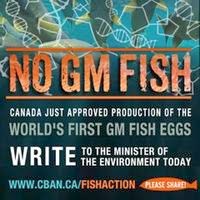What is the GM Salmon?
The U.S. company AquaBounty has genetically engineered (GE, also
called genetically modified or GM) Atlantic salmon. The company claims its
“AquAdvantage” salmon grow to market-size twice as fast as other farmed salmon.
That’s because the Atlantic salmon are engineered with a growth hormone gene
from Chinook salmon and genetic material from ocean pout (an eel-like
creature).
AquaBounty wants to produce all the GE Atlantic salmon eggs on
Prince Edward Island, ship them to Panama to grow out and then ship the
processed fish to the US consumer market. This is only the first part of the
company's plan - the plan they are seeking approval for now - they say they
want to grow the fish in North America, Chile and other countries, in the
future.
The GM Salmon is from Canada
Prince Edward Island, Canada is now home to the world's first GM
fish-egg production factory. In November 2013, Environment Canada announced its
decision to allow production of the GM fish eggs. The company has a
research facility at Bay Fortune in Prince Edward Island which it will turn
into a fish-egg factory if the U.S. and Panama also approve the fish.
No One Wants GM Fish
The Canadian
Aquaculture Industry Association and the International Salmon
Farmer's Association do not support the commercial production of GM fish.
Will GM Salmon Be On Our Plate Soon?
January 2014: Environmental groups are taking the federal
government to court for permitting manufacture of genetically modified salmon
in Canada. Ecology Action Centre (NS) and Living Oceans Society (BC),
represented by Ecojustice, assert that Canada's approval of GM fish production
is unlawful because it failed to assess whether genetically modified salmon
could become invasive, potentially putting ecosystems and species such as wild
salmon at risk. The Canadian government approval would permit egg production
and even the grow-out of GM salmon at other facilities in Canada, provided
criteria in the Minister of the Environment’s November 2013 notice are met.
January 2014: The GM salmon is very close to approval in
the U.S. but a timeline for a final decision is not known in the U.S. or in
Canada. In Canada, Health Canada refuses to tell the public if they are
currently assessing the salmon for human consumption.
November 2013: The Canadian government (Environment
Canada) gave the first-ever government approval for this GM fish when it
permitted the production of the GM fish eggs.
In late 2010, the U.S Food and Drug Administration (FDA)
made the preliminary conclusion that the GE salmon is safe for to eat and does
not pose a risk to the environment. But FDA meetings in September 2010 did not
conclude with a recommendation to approve the salmon. Instead, the FDA’s own
committee members voiced serious concerns about the quality of the data and the
risks. In January 2013, the US government released its environmental assessment
of the GE Atlantic salmon, a last step to approving the GE fish.
The First GM Food Animal in the World?
The GM fish was in a race with the GM pig called “Enviropig”
to become the first genetically engineered animal in our food system but the
campaign led by the Canadian Biotechnology stopped the GM pig in March 2012.
The GM salmon would be the first GM food animal approved in the world.
Environmental Risks
Atlantic salmon are farmed in both the Atlantic and Pacific
Ocean. The escape of farmed fish from either marine net pens or hatcheries is
serious, reoccurring pollution that threatens species. For example, mature
escaped Atlantic salmon have been recorded in streams in B.C..
To try to avoid a full review of these risks, AquaBounty is only
seeking permission to raise the fish in a land-based facility in a “remote
highland area” of Panama - even though they say they want to raise the fish in
the U.S. and other countries. The company also says that all the fish will be
sterile females, but admits they can only guarantee 95% of the salmon will be
unable to reproduce.
Any risk of GM Atlantic salmon escaping into the wild is unacceptable,
especially when Atlantic salmon are already in danger of disappearing.
Also, GM salmon could put even more pressure on marine
ecosystems. The fast-growing GM salmon could consume up to five times more food
than other farmed salmon - because salmon are carnivorous they actually eat
large amounts of wild-harvested fish like anchovies and sardines, caught just
to feed them.
Health Risks and Bad Science
Critics have long warned that the process of genetic engineering
itself could possibly result in increased allergenicity and AquaBounty’s own
data point to this potential in their GM salmon.
Dr. Michael Hansen, Senior Scientist at Consumers Union US,
says, “The FDA is relying on woefully inadequate data. There is sloppy science,
small sample sizes, and questionable practices.” For example, the company used
insensitive tests to try and measure the levels of growth hormone in the GM
salmon and the levels of IGF-1, a hormone linked to a number of cancers.
Resources
"Biotech
Gets Fishy with GE Salmon" Common Ground Magazine, Lucy
Sharratt, CBAN, October 2010.
